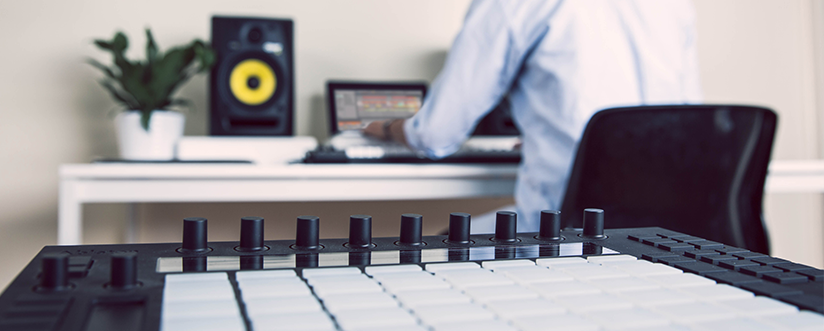“Music Theory” – these two words sure can sound rather dry & academic to a lot of music-makers, but what it’s really about is turbocharging your music-writing options & capabilities. While electronic music can be created without any music theory knowledge, learning even just the basics will save you time, give you more control over the mood & impact of your songs, and increase your understanding of what’s happening in other people’s music.
That aside, wherever your current music theory skills are at, there’s plenty of free Max for Live music theory tools & devices you can use to cut some corners and increase your music theory capabilities in Ableton Live.
Here, we’ve rounded up 4 free max for live music theory devices that we’ve found to be essential music theory secret weapons to enhance the music theory capabilities of both beginners and advanced users alike.
Keen to learn more? Check out Liveschool’s Music Theory essentials course.
Schwarzenator II
The Schwarzenator was created by Berlin based soul / jazz / electronica musician Henrik Schwarz as a solution to a problem.
His problem was that he never learned a traditional instrument or music theory, yet he’s fond of complex jazz-influenced melodies and harmonies.
As a solution, Henrik created the Schwarzenator. The Schwarzentaor allows the user to improvise (or program) simple melodies on the keyboard, that the device then transforms into complex chord progressions, all-the-while conforming to a selected key/scale – eliminating the possibility of hitting a “wrong note”.
The plugin can simultaneously do multiple things:
- fix the notes you play to a selected scale
- create complex chords from single notes
- change and randomise chord voicings and the note velocities within the chords
- and much more…
In essence, it will help you to create complex, changing chord progressions from very simple one-note-at-a-time MIDI melodies.
Watch the video below in which Henrik Schwarz explains it’s functions in detail, then download the free max for live device here.
Onscreen Keyboard
This device is oh-so simple, but oh-so useful.
It just does one thing – it shows the MIDI notes as they are being played back (or played in) as bright orange on the keyboard in real time.
This is super useful for preparing for a live performance – if you’ve written parts in MIDI (or extracted MIDI from a song or remix) and want to know how to play the parts on a physical keyboard, the on-screen keys will light-up showing you how to play and perform the parts. Slow the tempo of the project to a speed you’re comfortable with, then work your way up to the actual tempo as you get more fluent.
We’ve also been using it extensively for tutorials and presentations (no more air-keytar!).
It comes in two versions – a floating keyboard (created by Max for Live user “little scale”) and a keyboard that sits in the device view (modified from the little scale device by our resident Max for Live guru Vaughan Allan).
Download both versions here:
Download Floating on-screen keyboard
Download device view on-screen keyboard
Watch the video to learn how these simple devices were created in Max for Live:
Group Humanizer
UK musician James Holden is responsible for this set of amazing free Max for Live devices that are designed to introduce human-like timing errors into quantized MIDI parts. Incredibly, this set of devices doesn’t just induce human-like timing in a single part, rather it can emulate interdependent timing across multiple parts (i.e. your whole song) to achieve the overall feel, groove and mutual influence inherent in human accompaniment and jamming.
For the end user, this means being able to take multiple instances of quantized MIDI data across your entire song and give them a more human feel and groove. Not just a shortcut around keyboard playing skills, there’s a verifiable difference between playing with others and overdubbing takes of your own playing. This device applies subtle playing-with-others factors such as the amount of “influence” one player has over the timing of others.
A huge amount of work and research has gone into creating this device not only by James Holden himself. A group of Harvard University researchers documented the interactions between musicians and the impact these interactions have on the timing of each individual part.
Download the Group Humanizer devices here.
Learn more the about the study and the devices here.
Polyrythmus
Ever wondered if the Euclidean Algorithm of divisible numbers could apply to musical rhythms? Researcher and NY University professor Godfried Tuossaint did and found the answer is yes, they do. In fact, unbeknown to Euclid himself, these number combinations describe almost every known traditional musical rhythm from cultures around the world.
The Polyrhythmus device is described as a “modular euclidean rhythm builder” – a powerful sequencer and apreggiator, capable of playing several polyrhythmic patterns simultaneously.
Still making no sense? Thankfully, it includes a device randomisation feature – so even if you have no idea how it works, some great results can be achieved purely by generating infinite variations of randomised settings which in-turn will produce different arpeggiated sequences.
There’s a lot to learn about this complex device, so best to check out the video demonstration below by it’s creator Benniy C. Bascom for a full understanding of it’s features and capabilities.
Download the free max for live device here.
Subscribe to our newsletter to keep up with our latest free tutorials, samples, video interviews and more.
Learn more about our Music Theory essentials course.



